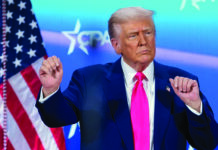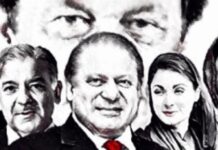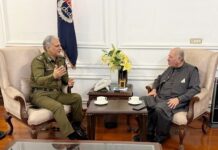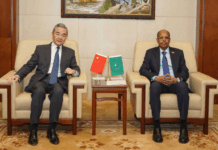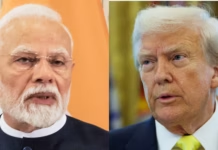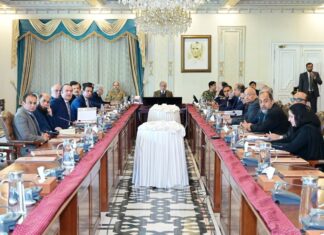While the opposition parties in the parliament have rejected the budget outright, dubbing it anti-people, and have vowed to obstruct its approval by the legislature, most of the economists, representative bodies of the business community and leaders of public opinion see it as a welfare and growth-oriented effort by the government. and rige htly so.
The budget, coming on the heels of the fiscal year 2020-21 which against all predictions of low growth rate depicted GDP growth by 3.94 percent –as a result of the steps taken during the year by the government, which was undeterred by the debilitating impact of covid-19– corroborates the government claims that the economy has achieved stability and was now poised for sustained growth, building on the momentum it has achieved, also giving the government the liberty to focus on welfare measures to ameliorate the condition of the masses and nudging the development process.
The onslaught of covid-19 had a devastating impact on the global economies besides the loss of lives it caused. The developing countries like Pakistan, which were already struggling to revive their economies, were severely hit by the pandemic, pulling down the GDP growth rate into the negative domain besides taking a toll on human lives, which thankfully was not as severe as in other countries of the world. Thanks to the prudent response devised by the government to deal with the challenge, its strategy based on protecting lives and livelihoods really worked as envisaged. The policy received international acclaim. It not only succeeded in saving lives but also in arresting a nosedive in the economy. The quick fiscal response by the Finance Ministry and the decisive steps taken by the central bank also supplemented the efforts to deal with the pandemic. To mitigate the sufferings of the people, the government also made cash transfers to them under the Ehsas emergency relief programme.
The package of incentives given to the construction sector, which was also given the status of an industry, to a great extent imparted a tremendous boost to the revival of the economy. The multiplier effect of the investments made in the construction industry and the industries linked to it, with 10 percent added by the large scale industry, imparted required impetus to the economy. Bumper crops of wheat, sugar cane, maize and cotton, increased revenue collections, higher remittances, and a 46 percent growth in the IT sector also helped the economy to go beyond the projected growth rate. Those who are rejecting the government claim of 3.94 percent GDP growth, saying that it was not possible given that the international financial institutions and even the government itself had projected GDP growth as being in the vicinity of 1.5 to 2.1 percent respectively, conveniently forget that projections are mere expectations on the basis of thr existing situation and can change due to change in the economic variables.
The detractors of the government and the opposition parties need to adopt a realistic attitude in regards to the state of the economy and the recipe suggested to fix the maladies afflicting it, instead of rejecting it outright. The budget is yet to be approved. The opposition is therefore well advised to play its role in in its finalization by presenting credible proposals which the government has already said would be duly accommodated.
The current budget builds on that growth momentum. To give further impetus to the economy, the government has raised the allocation for development projects by 40 percent. On the welfare plank the budget aims at targeting four to six million low-income households through specific economic empowerment measures including: each citizen will be eligible for an interest-free business loan of up to Rs 500,000; each farmer will be eligible for an interest-free loan of up to Rs.150,000; each farmer will be eligible for a loan of Rs 2,000,000 for purchase of agricultural implements; each low-income household will be eligible for an interest-free loan of Rs two million for building a house; each low-income household will receive a Sehat Insaaf card and one member of each household will be eligible for free skills training. These are indeed revolutionary steps aimed at changing the socio-economic profile of the society.
The decision by the government to reduce GST on locally assembled cars up to 850 CC to 12.5 percent from 17 percent in the budget, as well as the exemption from federal excise duty and value-added tax, will surely augur well for small-car buyers in terms of price relief. It would also lead to increased production and more jobs in the industry.
The government was also able to increase the defence budget to Rs 1370 billion which shows a 6.28 percent increase over the estimated allocations for the year 2020-21. The proposed defence allocations are 16.1 percent of the federal budget’s total outlay of Rs 8,480 billion.
The budget also focuses on generating more indigenous revenues which, logically speaking, are an indispensable imperative. The government has to lay more emphasis on raising indigenous revenues to finance projects in the socio-economic domain and to be able to provide relief to the masses. It rightly envisages raising Rs 5,829 billion in taxes compared to Rs 4,963 billion raised during the last fiscal year, an increase of 17.4 percent, by bringing traders and other non-tax paying sectors into the tax net. The enhancement of taxes will also lead to less borrowing.
The decision to avoid increasing taxes on salaried people and giving 10 percent ad hoc relief to them and the pensioners, rationalizing withholding taxes, avoiding taxation on the internet as had been proposed, and the launch of multiple development projects which would give employment to the many still unemployed after the covid-19 crisis suggests that the government was at least attempting to find a way to ameliorate some of the misery of people burdened by the high prices of petrol and other daily needs.
As is evident from the foregoing facts, the budget has something for every sector of the economy and the poor segments of the society who have been groaning under the impact of runaway inflation. The budget represents a plunge in the right direction. The Prime Minister was not off the mark when he said that all would be happy with the budget. In the given situation it was the best-ever effort by a sitting government to manage the economy.
The detractors of the government and the opposition parties need to adopt a realistic attitude in regards to the state of the economy and the recipe suggested to fix the maladies afflicting it, instead of rejecting it outright. The budget is yet to be approved. The opposition is therefore well advised to play its role in in its finalization by presenting credible proposals which the government has already said would be duly accommodated.

